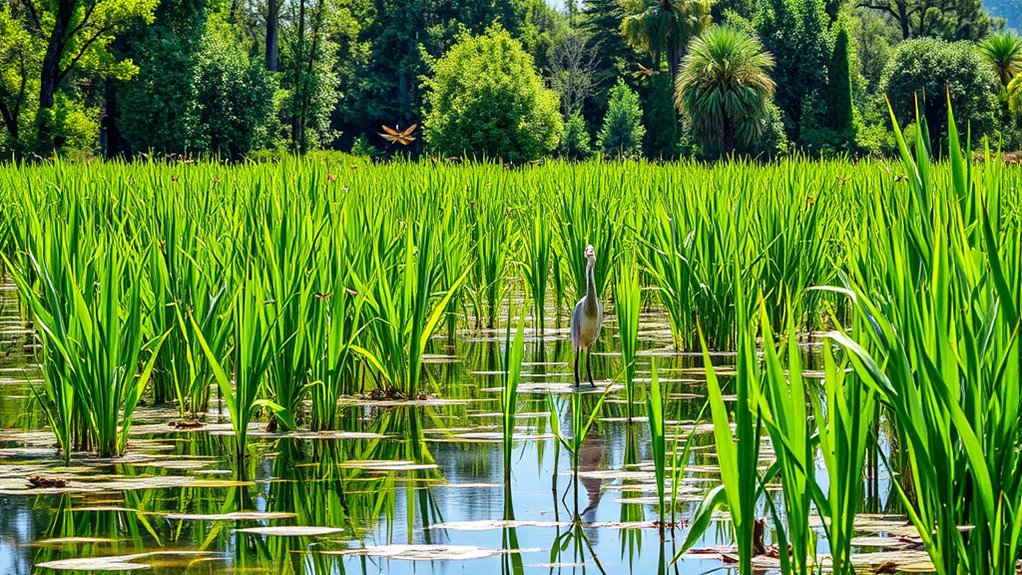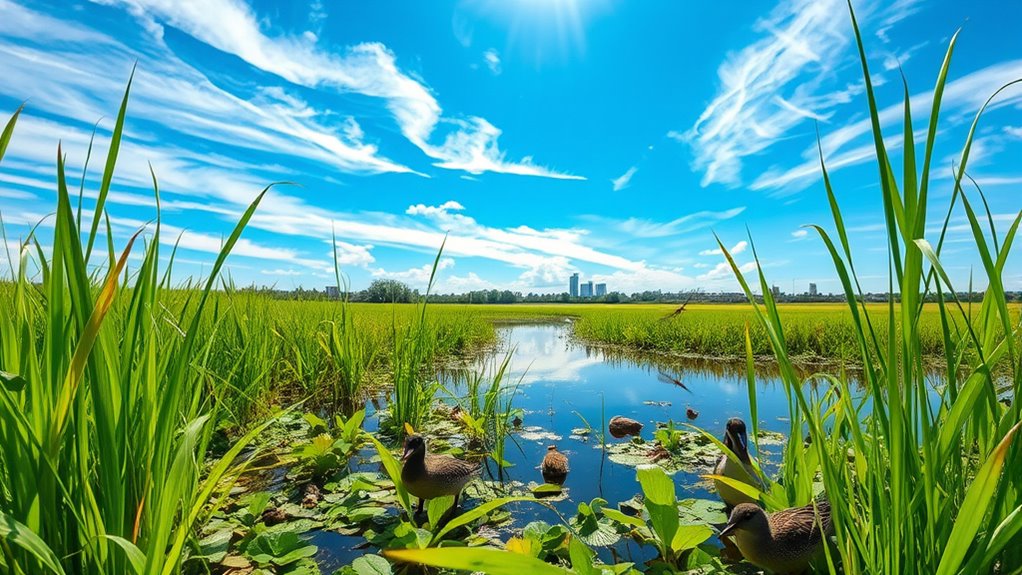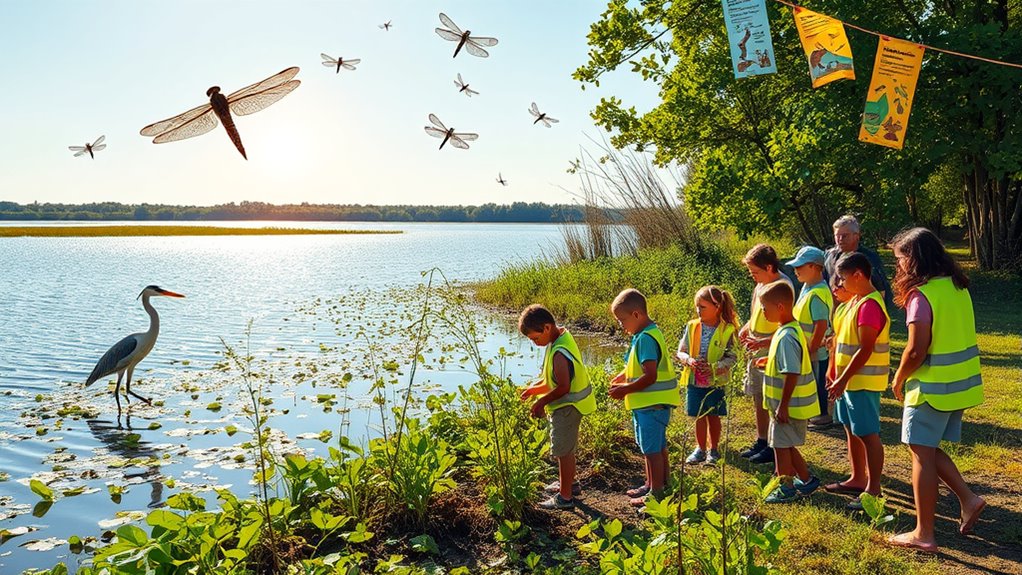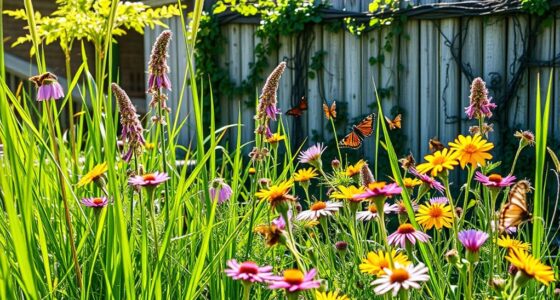Wetlands are vital for our environment. They improve water quality by filtering pollutants, absorb excess rainwater to reduce flooding, and provide habitats for diverse wildlife. To protect them, you can get involved with local conservation efforts, support sustainable agriculture, and advocate for wetland restoration. Every action counts in preserving these important ecosystems. If you want to discover more about how you can make a difference, keep exploring the ways to support wetland conservation.
Key Takeaways
- Wetlands are crucial for water quality improvement by filtering pollutants and absorbing excess nutrients, ensuring cleaner water for ecosystems and communities.
- They provide essential habitats for diverse plant and animal species, supporting biodiversity and acting as nurseries for aquatic life.
- Wetlands mitigate flooding by absorbing excess rainwater and maintaining water levels in rivers and streams, reducing flood risks.
- Protecting wetlands involves advocating for preservation efforts, restoring degraded areas, and implementing sustainable land-use practices to combat urban development and pollution.
- Address threats like invasive species and climate change through conservation initiatives to ensure the long-term survival and resilience of wetland ecosystems.
The Ecological Significance of Wetlands

Wetlands are vital ecosystems that play a crucial role in maintaining environmental balance. You mightn't realize it, but these areas filter pollutants, improving water quality in surrounding environments.
They also act like sponges, absorbing excess rainwater and reducing flood risks. When you walk through a wetland, you're stepping into a natural water management system that supports both wildlife and human communities.
Additionally, wetlands provide essential services, such as carbon storage, which helps mitigate climate change. By preserving these areas, you're not just protecting unique landscapes; you're also safeguarding vital resources for future generations.
Wetlands are crucial for carbon storage, helping combat climate change and preserving resources for future generations.
Understanding their ecological significance empowers you to advocate for wetland protection and encourages sustainable practices in your community. Every small effort counts in preserving these precious ecosystems.
Biodiversity and Habitat Preservation

How can we underestimate the role of wetlands in supporting biodiversity?
These unique ecosystems are home to countless plant and animal species, providing essential habitats for both aquatic and terrestrial life. By preserving wetlands, you're not just protecting a single environment; you're ensuring the survival of diverse species that rely on these areas for food, shelter, and breeding grounds.
Wetlands act as nurseries for fish and other wildlife, boosting populations and maintaining ecological balance. When you take steps to protect wetlands, you're also safeguarding these vital habitats against pollution, climate change, and urban development.
Your actions can foster a healthier ecosystem, contributing to the overall resilience of our planet's biodiversity while enriching your local environment and community.
Water Quality Improvement and Filtration

While many might overlook their importance, wetlands play a crucial role in improving water quality and filtration. They act like nature's sponges, absorbing excess nutrients and pollutants from the water that flows through them.
When you visit a wetland, you'll notice how plants and microorganisms work together to filter out harmful substances, making the water cleaner. This natural filtration process helps reduce the impacts of runoff from agricultural fields and urban areas.
By preserving wetlands, you're not just protecting diverse ecosystems; you're also ensuring cleaner water for drinking, recreation, and wildlife.
Flood Mitigation and Climate Resilience

Beyond their role in water quality, wetlands also serve as natural buffers against flooding and climate change impacts. They absorb excess rainwater, reducing runoff and protecting nearby communities from flood damage. By capturing stormwater, wetlands help maintain water levels in rivers and streams, preventing them from overflowing.
Wetlands act as vital buffers, absorbing rainwater and protecting communities from flooding while maintaining healthy water levels.
In a changing climate, wetlands enhance resilience by providing habitats that support biodiversity, which is essential for ecosystem health.
You can appreciate their value by advocating for wetland preservation and restoration in your area. Supporting policies that protect these ecosystems ensures they continue to mitigate flooding and adapt to climate challenges.
Every action counts, whether it's participating in local conservation efforts or spreading awareness about the importance of wetlands.
Threats Facing Wetlands

Wetlands face numerous threats that jeopardize their health and functionality. Urban development often leads to the draining and filling of these vital areas, diminishing their size and ecological balance.
Pollution from agricultural runoff and industrial waste contaminates water quality, harming the diverse species that rely on wetlands. Invasive species can outcompete native plants, disrupting the natural habitat and reducing biodiversity.
Additionally, climate change poses a significant risk by altering water levels and increasing the frequency of extreme weather events. These factors collectively threaten the ecosystem services wetlands provide, such as flood control and water filtration.
To ensure their survival, it's crucial to recognize these threats and take action to mitigate their impact on wetland environments.
Community Involvement and Education

Understanding the importance of wetlands is crucial for fostering community involvement and education. When you recognize their role in biodiversity, flood management, and water purification, you're more likely to engage in protecting them.
Local workshops and school programs can help raise awareness, teaching you and your neighbors about wetland ecosystems. Participating in community events, like clean-up days or guided tours, strengthens your connection to these vital areas.
You don't have to be an expert; sharing your knowledge and enthusiasm can inspire others to care. Collaborating with local organizations also enhances your efforts, creating a community network dedicated to wetland conservation.
Together, you can make a difference, ensuring that future generations appreciate and benefit from these invaluable ecosystems.
Practical Steps for Wetland Conservation

While you may feel overwhelmed by the challenges of wetland conservation, there are practical steps you can take to make a real impact. Start by educating yourself about local wetlands and their importance.
Volunteer for local conservation groups or participate in clean-up events. You can also advocate for wetland protection policies by contacting your local representatives.
If you own property near wetlands, consider implementing buffer zones to reduce runoff. Plant native vegetation to support local wildlife and improve water quality.
Finally, engage your community by organizing workshops or informational sessions to raise awareness. Every small action counts, and together, you can foster a culture of conservation that protects these vital ecosystems for future generations.
Frequently Asked Questions
What Types of Wetlands Exist Around the World?
You'll find several types of wetlands around the world, each with unique characteristics.
Marshes are dominated by herbaceous plants, while swamps feature woody vegetation.
Bogs, rich in peat, are acidic and nutrient-poor, while fens are groundwater-fed and less acidic.
Coastal wetlands, like mangroves and salt marshes, thrive along shorelines.
Each type plays a crucial role in their ecosystem, providing habitat, filtration, and flood control, so it's essential to understand their diversity.
How Do Wetlands Affect Local Weather Patterns?
Wetlands play a crucial role in influencing local weather patterns. They help regulate temperature and humidity by storing water, which evaporates and contributes to cloud formation.
You'll notice that areas near wetlands often experience milder temperatures and increased rainfall. By absorbing excess rainwater, wetlands also reduce the risk of flooding, helping to maintain a balanced ecosystem.
Can Wetlands Be Restored Once Damaged?
Yes, wetlands can be restored once damaged. You can help by supporting restoration projects that focus on replanting native vegetation, creating water channels, and removing pollutants.
When you invest time and resources into these efforts, you contribute to revitalizing the ecosystem. Engaging with local organizations also amplifies your impact, as they often have the expertise and resources to execute successful restoration plans.
Together, you can help bring these vital habitats back to life.
What Role Do Wetlands Play in Carbon Storage?
Imagine wetlands as nature's sponges, soaking up carbon like a thirsty traveler.
They play a vital role in carbon storage by trapping carbon dioxide in their rich soils and vegetation.
When you walk through these lush landscapes, you're stepping on a carbon reservoir that helps mitigate climate change.
Are There Specific Laws Protecting Wetlands?
Yes, there are specific laws protecting wetlands.
You've got the Clean Water Act, which regulates discharges into waters, including wetlands.
The National Environmental Policy Act requires federal agencies to assess the environmental impact of their actions.
Additionally, many states have their own regulations to safeguard wetlands.
It's important for you to stay informed about these laws, as they play a crucial role in preserving these vital ecosystems for future generations.
Conclusion
In conclusion, protecting wetlands isn't just about preserving nature; it's about safeguarding our communities and future. For instance, a town in Louisiana implemented a wetland restoration project that not only improved water quality but also reduced flooding during hurricane season. By getting involved in local conservation efforts, you can help ensure these vital ecosystems thrive. Every action counts, whether it's volunteering for cleanup events or advocating for policy changes. Together, we can make a difference for wetlands and ourselves.









